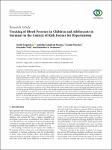Tracking of Blood Pressure in Children and Adolescents in Germany in the Context of Risk Factors for Hypertension
Sarganas, Giselle
Schaffrath Rosario, Angelika
Niessner, Claudia
Woll, Alexander
Neuhauser, Hannelore
Blood pressure (BP) tracking from childhood to adulthood has two aspects: the ranking stability relative to others over time and the prediction of future values. This study investigates BP tracking in children and adolescents in Germany in the context of hypertension risk factors. BP was measured and analyzed in 2542 participants of the German Health Examination Survey for Children and Adolescents (t0 2003-2006; 3 to 17-year olds) and of a six year follow-up “Motorik Modul” (t1 2009-2012; 9 to 24-year olds). BP tracking coefficients were calculated from Spearman’s rank-order correlations. Predictive values and logistic regression models were used to forecast t1-BP above the hypertension threshold from t0-BP as well as from baseline and follow-up hypertension risk factors. BP tracking was moderate (0.33-0.50 for SBP and 0.19-0.39 for DBP) with no statistically significant differences between sex and age groups. Baseline hypertensive BP was the strongest independent predictor of hypertensive BP at follow-up (OR 4.3 and 3.4 for age groups 3-10 and 11-17 years) after adjusting for sex, BMI trajectories, birthweight, parental hypertension, and age-group dependent-sports/physical activity. However, the positive predictive value of baseline hypertensive BP for hypertensive BP at follow-up in 3- to 10-year olds was only 39% (34% in 11- to 17-year olds) and increased only moderately in the presence of additional risk factors. Our analysis with population-based data from Germany shows that BP in children and adolescents tracks only moderately over six years. BP in childhood is the strongest independent predictor of future BP but its predictive value is limited.
Files in this item

